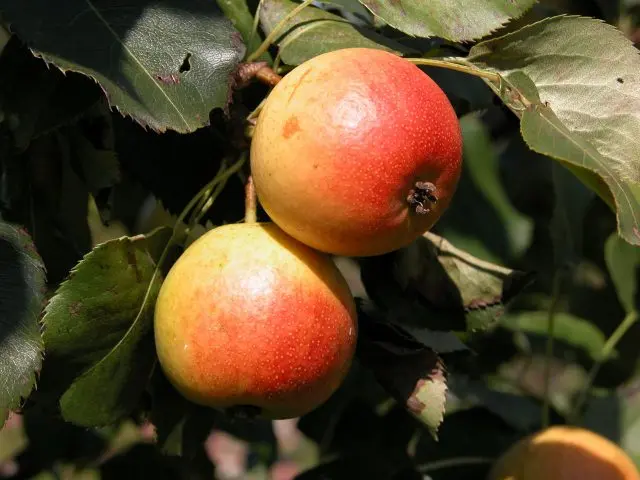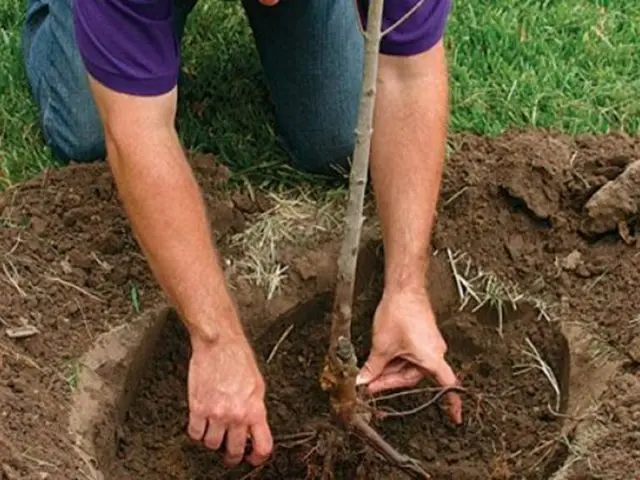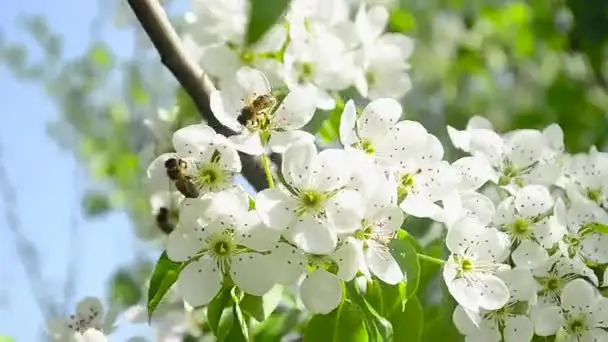Contents
The Thumbelina pear was obtained by hybridization at the VSTIS in Moscow. By the method of pollination of hybrid No. 9 and several southern varieties, a fruit crop of autumn ripening was taught. The originators of the variety N. Efimov and Yu. Petrov in 1995 transferred the pear to experimental cultivation. A fruit tree was zoned in the Central part of the Federation, in 2002 the culture was entered in the State Register. The description of the variety, photo, reviews about the Thumbelina pear of gardeners cultivating this plant will help to learn more.
Description of the pear variety Thumbelina
Culture refers to the medium-late ripening period. Pears reach biological ripeness by mid-September, the dates are focused on the central part of Our Country and the Moscow region. The variety is adapted to temperate climates. It is characterized by high frost resistance. Tolerates temperatures down to -38 without freezing the root system and shoots0 C. Pear gives a stable harvest regardless of weather conditions. The taste of fruits is not affected by an insufficient amount of ultraviolet radiation. The early maturity of the Thumbelina pear is average, the first crop gives after 6 years of vegetation. The fruit tree blooms late, it is not afraid of return spring frosts. This factor is the key to a high yield.
External description of the Thumbelina pear:
- It reaches a height of up to 1,7 m, the crown is dense, sprawling. Branches of medium volume, erect, slightly drooping. The color of perennial trunks is brown, young shoots are maroon, after 1 year of vegetation they acquire a common color with the central branches.
- Leaves with a smooth, glossy surface, medium size, oval, narrowed, with numerous small teeth along the edge.
- The flowers are white, collected in inflorescences. Ringlets are formed along the branches, the place is the formation of inflorescences, then fruits. The variety blooms profusely, the percentage of shedding of flowers is low, the ovaries are formed in 95%. The variety is self-fertile, the flowers are bisexual.
Fruit Characteristics
Thumbelina pear with small fruits, category of dessert varieties. The composition is dominated by glucose, the concentration of titratable acids is insignificant. Photosynthesis does not require a lot of ultraviolet light, so the taste of the fruit will not change in a rainy, cold summer. The pear ripens in early autumn, it is recommended to harvest in a timely manner. Ripe fruits are prone to shedding. The structure of the pear is of a dense consistency, the fruits are stored for a long time, suitable for preservation.

The photo of Thumbelina pear fruits corresponds to their description:
- the shape is round, symmetrical, regular;
- the stalk is thin, long, easily separated from the annulus;
- fruits weighing 80 g, ripen simultaneously;
- the peel during technical ripeness is green with a yellow tint, the blush is weakly expressed, light red, at the time of ripening the peel is yellow, the spot acquires a crimson hue, increases in size;
- the surface is even with numerous brown dots;
- the pulp is yellow, dense, juicy, aromatic, without granulation.
After harvesting, the fruits retain their taste and presentation for about 14 days.
Pros and cons of the variety
The Thumbelina pear is grown for its excellent taste characteristics. In addition to the taste of the fruit, the variety has a number of positive characteristics:
- stable yield, regardless of weather conditions;
- aesthetic appearance;
- small fruit tree, takes up little space on the site;
- photosynthesis is not disturbed with a deficiency of ultraviolet radiation;
- frost resistance;
- long shelf life of fruits;
- resistance to infections and garden pests.
The disadvantages include:
- after ripening, the fruits crumble;
- exactingness for watering at the time of formation of the ovary.
Optimal growing conditions
The fruit culture is zoned in the climatic conditions of the Central regions. The variety is fully adapted to temperate climates. Due to frost resistance, pear is grown in the Moscow region, the Volga-Vyatka region, and is found in the Urals.
The Thumbelina pear is quite unpretentious in agricultural technology, gives a stable crop even with insufficient sunlight. Can grow in the shade of tall trees. It will bloom at a relatively low temperature, a self-fertile culture gives a lot of ovaries, in order to preserve them, abundant watering is required in late spring and the first decade of June. The Thumbelina pear does not tolerate the influence of the north wind, in order to protect the fruit tree from drafts, it is planted behind the wall of the building on the south or west side.
The soil for the Thumbelina pear is preferably neutral or slightly alkaline, loam is suitable, the best option is sandy loam. The culture needs watering, but constantly waterlogged soil can cause the root system to rot and the tree to die. Therefore, the pear should not be placed in lowlands where rainwater accumulates, in wetlands with close groundwater.
Planting and caring for Thumbelina pear
You can plant Thumbelina pear in spring and autumn. Taking into account that the halo of the spread of culture is regions with cold winters, more often planting work is done in the spring. During the warm season, the young tree will get sick and take root well. If a pear is planted in the fall, they are guided by the regional features of the climate, at least 3 weeks should remain before the onset of the first frost. In the Moscow region – around the beginning of October.
Planting material is purchased from nurseries with a good reputation, 2-year-olds. The seedling should be with the first circle of skeletal branches, intact bark on the trunk of a dark brown color. Also with a well-formed root system without mechanical damage, visually determined by the grafting site.

Rules of landing
A week before the planned planting of the seedling, a planting hole of 80 * 60 cm is prepared. The upper fertile soil is mixed with sand and organic matter in equal parts, then potassium-phosphorus fertilizer is added in the amount indicated in the instructions. The pear root is dipped for 4 hours in a solution of water with “Epin” to stimulate growth.
Sequencing:
- Retreat 15 cm from the center of the pit, drive in a stake.
- The fertile mixture is divided into 2 parts, one is poured onto the bottom of the planting hole, a hill is formed in the form of a cone in the center.
- If the seedling is in a container, the mixture is laid in an even layer, the pear is placed in the center with an earthen clod by the transshipment method.
- The roots of planting material without a container are distributed evenly over the pit.
- Fall asleep with the second part of the soil mixture, with soil on top.
- Seal the root circle, water.
- Fix the trunk to the post.
Watering and top dressing
Pear Thumbelina begins to bear fruit for 6 years after being placed in the ground. Fertilizers are applied during planting, they are enough for 3 years. If the soils are acidic, in the fall, before planting, they are neutralized with dolomite flour. At the 4th year of growth, the procedure is recommended to be repeated. If this measure is not necessary, it is enough to add compost diluted in water under the root in the spring.
The main pear feeding is required for 6 years. During flowering, saltpeter is scattered around the tree, fed with urea. When the ovaries are formed, Kafor is applied, during the period of fruit ripening, top dressing is carried out with magnesium sulfate. In autumn, organic matter is introduced, mulched with peat. The Thumbelina pear does not belong to drought-resistant varieties, watering is carried out as needed, the main one is during the period when the ovaries appear. If the summer is rainy, watering is not needed. Do not allow waterlogging of the soil.
Trimming
The Thumbelina pear does not form a crown with skeletal branches, so cardinal pruning is not required for the fruit tree. Enough sanitary cleaning in the spring before the start of sap flow. Remove dry fragments. Young shoots are thinned out so that the fruits receive more nutrients during ripening. The tree is compact, the branches are upright, they can be shortened by a few cm if desired.
Whitewash
Thumbelina pear is whitened 2 times a year in spring and autumn. In addition to the aesthetic direction, the event is preventive in nature. Larvae of garden pests wintering in the bark and spores of the fungus die after treatment. Whitewash the tree about 60 cm from the ground, use acrylic paint, lime or a water-based emulsion. A coating applied to the pear in spring will protect the bark from sunburn.
Preparation for winter
Before the onset of frost, the Thumbelina pear is watered abundantly, the soil of the root circle is loosened first. Mulch with dry sawdust or pine needles. It is recommended to cover a young tree up to 3 years of growth with spruce branches. They put arcs, cover with a special material that does not allow moisture to pass through. In winter they are covered with snow.
Thumbelina pear pollinators
The pear variety Thumbelina is self-fertile, pollination takes place within 1 tree due to flowers of different sexes. Cross-pollination is recommended to improve pear yield. Choose crop varieties with the same flowering time. Krasnoyarsk large, Veselinka and Sibiryachka are suitable as pollinators. Trees are located on the plot within 10 m from the Thumbelina pear. If varieties suitable for pollination are located in an adjacent area, this will be sufficient.

Productivity
The culture blooms in the second half of May, when there is no threat of spring frosts, so the flowers do not fall off, which is a guarantee of productivity. The ovaries are prone to shedding, they can be preserved by timely watering. The variety is undersized, for its size it gives a good harvest – from 1 unit. collect 15-25 kg of fruit. To improve the fruiting rate, a cutting is grafted onto the stock of a high-growing representative of the fruit crop.
Diseases and pests
The most common disease affecting fruit trees is scab. Thumbelina pear has a strong immunity against fungal infection. The threat to the pear is:
- Mučnistaâ rosa – the fungus spreads along the crown and branches in the form of a gray coating. Against the infection, “Fundazol” or “Sulfite” is used.
- Black Cancer – affects the bark of a tree, the initial manifestation in the form of corrosion, without treatment, deep wounds appear. The tree is treated with copper sulphate. In autumn, the affected areas are covered with soda var, the leaves and dry branches are burned.
- Moniliasis – causes rotting of fruits, if they remain on the tree, then the infection spreads to all pears. If a disease is detected, the affected fruits are removed, the tree is treated with Bordeaux liquid.
Of the garden pests, the gall mite parasitizes on the Thumbelina pear. In early spring, for preventive purposes, the Inta Virom fruit crop is sprayed. Before the formation of fruits, they are treated with colloidal sulfur.
Reviews about the pear Thumbelina
Conclusion
The biological description of the variety, photos, reviews of the Thumbelina pear fully correspond to the characteristics declared by the originators. The variety is zoned in the climatic conditions of Central Our Country, adapted to low temperatures. The culture does not require special agricultural technology, it has good immunity to fungal infections. Gives fruits with high gastronomic evaluation.









